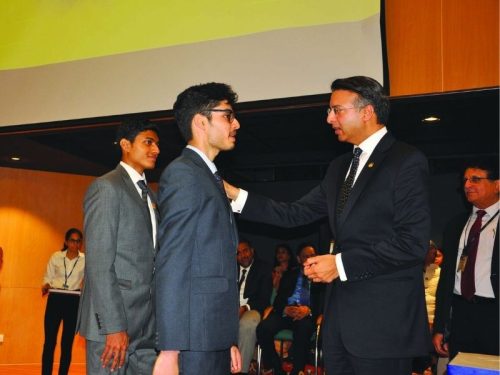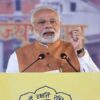India’s top-ranked private universities 2022-23
Currently, 403 private universities and 126 deemed (private) universities licensed by the Central government are on the 1,027-strong list of Indian universities approved by the Delhi-based University Grants Commission. According to some estimates, more than 70 percent of India’s youth in higher education are in private HEIs, writes Dilip Thakore

Amity University’s Dr. Atul Chauhan
Contrary to popular belief, privately-promoted higher education institutions (HEIs) — undergrad colleges and universities — have made a substantial contribution to post-independence India’s nation-building effort. Although with India having foolishly adopted the Soviet-inspired “socialistic pattern of development” and central planning immediately after attaining political independence from British rule, it became fashionable to vilify private education providers as capitalist exploiters, despite official discouragement, there’s been a steady growth in the number of private HEIs. For the simple reason that neither the Central nor state governments have sufficiently invested in education.
Way back in 1967, the high-powered Kothari Commission recommended that the government (Centre plus states) should invest “at least” 6 percent of GDP in public education, but that target has never been attained. For the past 75 years, government investment in public education has averaged 3.25-3.5 percent per annum.
A direct consequence of taking the populist socialist road to perdition has been that the country’s population has tripled to over 1 billion, because central planners were unaware that universal education is the best contraceptive. The original sin of under-investment in public education was compounded by conspicuous failure to supervise the quality of education dispensed in government schools and higher education institutions. As repeatedly highlighted in the Annual Status of Education Report (ASER) of the Pratham Education Foundation, over 55 percent of class V children in government rural primaries can’t read class II textbooks.
In higher education, 85 percent of the country’s arts, science and commerce graduates — especially of HEIs promoted by state governments — are not sufficiently qualified for induction into Indian and foreign multinationals, according to Aspiring Minds, a Delhi-based human resources recruitment company.
Currently, 403 private universities (the majority licensed by state governments) and 126 deemed (private) universities licensed by the Central government are on the 1,027-strong list of Indian universities approved by the Delhi-based University Grants Commission (UGC). According to some estimates, more than 70 percent of India’s youth in higher education are in private HEIs.
Therefore since the EWIHER were introduced in 2013, your editors have been rating and ranking private and government/public universities separately on the reasoning that they tend to have totally different institutional cultures, tuition fee and accountability structures. In particular, with tuition fees frozen for decades in government HEIs, the modest tuition and other fees levied by private universities — albeit very modest by international standards — have drawn continuous criticism from academics and media pundits who foolishly expect and demand that all education institutions must be run as charities, a chorus sanctified by the Supreme Court and the upper judiciary. Nevertheless despite harassment and red-tape, the number of private universities has steadily increased and they have made a significant contribution to the steady growth of the Indian economy and emergence of the country’s contemporary 250-300 million middle class.
[userpro_private restrict_to_roles=administrator,customer]
Although in EWIHER 2022-23, we have maintained our tradition of evaluating and ranking private and government universities separately, in the cause of continuous improvement, we have further classified public and private universities into multi-disciplinary; liberal arts and humanities; engineering & technology; medical and life sciences and ranked the Top 100 private B-schools. We believe this filtering and refinement of government/public and private universities into streams will make it easier for students and scholars to choose HEIs most suited to their aptitudes and aspirations.
India’s most admired private multidisciplinary universities
With the restructuring and refinement of previous years league tables to enable peer institution evaluation, except at summit levels there’s been considerable rearrangement of the seating order at the Top 10 table
As indicated in the introduction to EWIHER 2022-23, 4,105 sample respondents comprising HEI faculty and students, and industry leaders were persuaded by field personnel of the Delhi-based market research and opinion polls company C fore to rate the country’s most high-profile universities — including multi-disciplinary — on ten parameters of higher education excellence. The scores awarded by the sample respondents to private universities under each parameter were totalled to rank private multidisciplinary universities inter se.
With the restructuring and refinement of last year’s league tables to enable peer institution evaluation, except at summit levels there’s been considerable rearrangement of the seating order at the Top 10 table. Evidently, an intensive multi-media, especially television, campaign heralding the high ranking awarded in the QS and THE World University Rankings to Amity University, Noida has influenced the EW sample respondents to vote it India’s #1 private multidisciplinary university this year. This brings to an end the long six-year reign of the low-profile and under-promoted Manipal Academy of Higher Education (MAHE) in the EWIHER league tables. Although pushed to #2, MAHE has the distinction of being awarded the highest scores under the critical parameter of research & innovation — given the highest weightage (300) among all parameters of excellence — and infrastructure (150).
“In recent years, Amity University, Noida has been highly ranked in several categories by international rating agencies including QS and THE. We are very happy and proud that we are also ranked India’s #1 private multidisciplinary university by EducationWorld, the premier education magazine in India. Under the visionary leadership of our founder Dr. Ashok K. Chauhan, we are committed to benchmarking AU with the best universities worldwide. More than a decade ago, we decided to plant the Indian flag around the world through Amity institutions. Now we have our own campuses in 12 countries and cities including London, New York, San Francisco, Amsterdam, Singapore, Dubai, Abu Dhabi, Pretoria, Quatre Bornes (Mauritius) and Tashkent. Our global network enables great synergies with academia and industry around the world. I am proud of the leadership of the university and all the faculty and scientists who work like one family to conduct breakthrough research and innovation. For our focus on research and innovation, the Government of India recently conferred on Amity University the national award for IPR and innovation. Our deep focus on industry engagement globally and investing students with the skills and mindset industry needs, has made us one of only six Indian institutions — most of them IITs and IIMs — to be ranked by Times Higher Education, as a university nurturing the most employable graduates,” says Dr. Atul Chauhan, an alum, the London School of Economics and University College, London and chancellor of the pioneer Amity University, Noida.
With Amity University, Noida having charted a path and providing a model, several autonomous Amity universities have also won golden opinions from EW sample respondents. Amity University, Jaipur piloted by brother Aseem Chauhan is ranked #10 in this year’s private multidisciplinary varsities league table and Amity U, Lucknow is ranked #13. Moreover, Amity U, Gurugram is ranked #16 and AU, Mumbai #28. Currently, AU, Noida which has campuses in Noida, Greater Noida and Lucknow has an aggregate enrolment of 17,000 students and the Amity Group (17 schools, 11 universities in India and 11 abroad) has an aggregate enrolment of 175,000 students mentored by over 15,000 teachers and faculty.

Chitkara University’s Madhu Chitkara
Disaggregation and rationalisation of previous year’s league tables has also enabled several private multidisciplinary universities to improve their standing. Amity University which has ended the six-year reign of the Manipal Academy of Higher Education, is ranked higher by a single point in this year’s league table. MAHE at #2 is followed by the Amrita Vishwa Vidyapeetham University, Coimbatore and NMIMS Deemed University, Mumbai jointly awarded a big promotion to #3 from #9 in 2021-22. Shiv Nadar University, Gautam Buddha Nagar (UP) promoted to #4 (8) and ICFAI University, Hyderabad at #5 (9) complete the high table.
Beyond high table, several private multidisciplinary universities have substantially risen up the ladder of this separate and distinct league table introduced this year. Krea University, Sri City (Andhra Pradesh) has been promoted to #6 (11); Symbiosis International, Pune to #7 (10); Christ Deemed University, Bengaluru is #8 (12); LNM Institute of Technology, Jaipur #9 (15) and Chitkara University, Chandigarh #10 (20).
“We are super delighted to learn that Chitkara University is ranked among India’s Top 10 private multidisciplinary universities and #1 in Punjab! Such recognitions go a long way in keeping our levels of motivation and enthusiasm high. This accolade is undoubtedly the outcome of team effort. First and foremost, credit is due to our highly committed faculty and their unwavering focus and single-minded devotion to the welfare of our students even during the height of the Covid pandemic, when they overcame all road-blocks to switch to online teaching. Second, it’s the result of the large number of partnerships we have contracted with prestigious universities overseas, making the whole learning experience of our students cosmopolitan and enriching. Our USP, of course, remains our placement record and industry-connect. I believe the combination of these factors has enabled us to rise in the public esteem and I am very happy to have played my part in catalysing this growth,” says Madhu Chitkara, pr0-chancellor of CU. Currently, CU has 20,000 students and 1,850 faculty on its muster rolls.
Following reclassification of the EWIHER 2022-23 into segregated league tables, most private multidisciplinary varsities have improved their ranking considerably this year. For instance beyond the Top 10, the research-oriented Shoolini University, Bajhol (Himachal University) has been promoted to #14 from #20 in 2021-22 and #1 in Himachal Pradesh; Jagran Lake City University to #15 (30); Presidency University, Bengaluru to #19 (32) and #2 in Karnataka. With engineering, liberal arts and social sciences teaching and research universities ranked in separate, dedicated league tables, almost all multidisciplinary varsities have deservedly been awarded their rightful place in the sun.
Moreover, for school-leavers and scholars who prefer signing up with multidisciplinary universities which allow access to a wider range of subjects, it’s pertinent to note that universities modestly ranked in the national league table may well be highly ranked in their host states and cities. For instance, Marwadi University, Rajkot ranked #24 in India is the #1 multidisciplinary university in the western sea-board state of Gujarat (pop. 63 million).
Similarly, the low-profile Siksha ‘O’ Anusandhan (Deemed University), Bhubaneswar India #20 is top-ranked in Odisha (pop. 47 million); and Jagran Lake City, Bhopal India #15 is the #1 private multidisciplinary university in Madhya Pradesh (pop.87 million). Students reluctant to travel beyond state boundaries should carefully study the state rankings of multidisciplinary universities.
Also Read
















Add comment